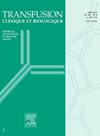Stratified analysis of risk factors affecting vasovagal reactions in first-time whole blood donors: A regional multi-center donor hemovigilance data study
IF 1.2
4区 医学
Q4 HEMATOLOGY
引用次数: 0
Abstract
Background and objectives
Vasovagal reactions (VVR) are the most common adverse reactions in blood donation. This study aimed to provide and analyze the data of the regional hemovigilance system in Chongqing, China from 2020 to 2022, report the prevalence and explore the risk factors of VVR.
Materials and methods
R software (version 4.2.3) was used for all statistical analyses. Frequency and composition rates were used to describe the data of total donation, as well as data on the different types of ADR. The Chi-square test was used to analyze risk factors for VVR and inter-group comparisons of VVR stratified by gender (female/male), age (18–22; 23–29; 30–39; 40–49; 50–60) and season(Spring (Mar.-May.); Summer (Jun.-Aug.); Autumn (sep.-Nov.); Winter (Dec.-Feb.)).
Results
The reported incidence rate of VVR was 8.69‰ during whole blood donations and 1.02‰ during platelet-apheresis donations.The stratified analysis revealed that female donors aged 18–22 years old and 30–39 years old were reported to have lower VVR rates than male donors, oppositely, higher in females in 50–60 years old. Statistically significant differences in the incidence rate of VVR were observed between winter and summer, and between winter and spring in 18–49 years old. No seasonal variation was found in 50–60 years old.
Conclusions
The reported incidence rate of VVR related to blood donation was very low and varied from those calculated by other haemovigilance systems. The higher prevalence of VVR in young, first-time donors, college students, donating in mobile vehicles, males and in spring. Among first-time donors, the prevalence of VVR was higher in males than in females; and stratified analysis revealed there were seasonal variation and gender differences within a same age group.
影响首次全血献血者血管迷走神经反应的风险因素分层分析:地区性多中心献血者血液监测数据研究。
背景和目的:血管迷走反应(VVR)是献血过程中最常见的不良反应。本研究旨在提供并分析 2020 年至 2022 年中国重庆地区血液监测系统的数据,报告 VVR 的发生率并探讨其风险因素:所有统计分析均使用 R 软件(4.2.3 版)。使用频数和构成率描述总捐献数据,以及不同类型 ADR 的数据。采用卡方检验分析 VVR 的风险因素,并按性别(女性/男性)、年龄(18-22 岁;23-29 岁;30-39 岁;40-49 岁;50-60 岁)和季节(春季(3 月-5 月);夏季(6 月-8 月);秋季(7 月-11 月);冬季(12 月-2 月))对 VVR 进行组间比较:分层分析显示,18-22 岁和 30-39 岁女性献血者的 VVR 发生率低于男性献血者,相反,50-60 岁女性的 VVR 发生率高于男性献血者。据统计,在 18-49 岁人群中,冬季和夏季以及冬季和春季的 VVR 发生率存在明显差异。在 50-60 岁的人群中没有发现季节性变化:报告的与献血有关的 VVR 发生率非常低,与其他血液监测系统计算的发生率不同。年轻献血者、首次献血者、大学生、流动献血车上献血者、男性和春季献血者的 VVR 发生率较高。在首次献血者中,男性的 VVR 发生率高于女性;分层分析表明,在同一年龄组中存在季节性差异和性别差异。
本文章由计算机程序翻译,如有差异,请以英文原文为准。
求助全文
约1分钟内获得全文
求助全文
来源期刊
CiteScore
2.50
自引率
11.80%
发文量
234
审稿时长
36 days
期刊介绍:
Transfusion Clinique et Biologique, the official journal of the French Society of Blood Transfusion (SFTS):
- an aid to training, at a European level
- the only French journal indexed in the hematology and immunology sections of Current Contents
Transfusion Clinique et Biologique spans fundamental research and everyday practice, with articles coming from both sides. Articles, reviews, case reports, letters to the editor and editorials are published in 4 editions a year, in French or in English, covering all scientific and medical aspects of transfusion: immunology, hematology, infectious diseases, genetics, molecular biology, etc. And finally, a convivial cross-disciplinary section on training and information offers practical updates.
Readership:
"Transfusers" are many and various: anesthetists, biologists, hematologists, and blood-bank, ICU and mobile emergency specialists...

 求助内容:
求助内容: 应助结果提醒方式:
应助结果提醒方式:


